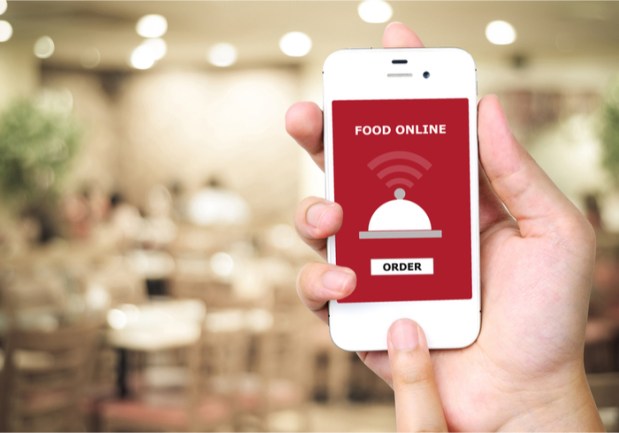QSRs Ramp Up Mobile Order-Ahead Offerings

Consumers want their morning cup of joe, but they don’t want to wait on line. With mobile ordering at quick-service restaurants (QSRs) like The Coffee Bean & Tea Leaf, customers can ditch the queue.
“When people want coffee or tea, they want it now, and we want their orders to be ready when they are,” Aidan Hay, SVP of Operations at The Coffee Bean & Tea Leaf, said in a press release announcing a mobile order-ahead feature for their app.
The Coffee Bean & Tea Life is hardly alone. QSRs from Dunkin’ Donuts to Subway are jumping on the mobile order-ahead bandwagon. It’s a market that is estimated to be worth $55 billion in the next five years, according to the PYMNTS Mobile Order-Ahead Tracker. Here’s how QSRs are integrating mobile order-ahead technology into their stores and where the innovation is headed in the future.
— Two in 10 — or 20 percent — of Dunkin’ Donuts’ high-volume urban location transactions are mobile orders. In fact, Dunkin Donuts’ new Quincy, Massachusetts, location has a dedicated mobile order pick-up area and is testing out its first ever drive-through exclusively for those who ordered ahead using the DD Perks app. The new location also comes with line-busting kiosks that allow customers to order on a screen — no human interaction necessary. Quincy is the first of what the coffee brand is calling concept shops that are set to open throughout the rest of the year. The new store has also updated Dunkin’ Donuts’ signature look, dropping the brown, dark orange and bright pink in favor of a lighter, more naturalistic color scheme. What remains the same are the beverages — though new elements like cold brew coffee have crept onto the menu.
— Nearly six in 10 — or 57 percent — of restaurant apps support mobile order-ahead and pickup. When Panera Bread first rolled out its mobile order-ahead service in 2012, for example, the idea was to attract consumers wary of waiting in lines for service. Five years in, the bakery/café chain is taking its restaurant readiness strategy to the next level with voice-enabled mobile ordering offerings. Last year, the St. Louis, Missouri-based company partnered with Google to allow customers to place orders using simple phrases like, “OK, Google, ask Panera for delivery,” or “OK, Google, talk to Panera.” The service, which uses the Google Assistant’s display menu, makes suggestions based on order history, walks customers through menu items and enables them to pay with their saved payment methods. As of 2017, it seemed that consumers were readily adopting mobile voice order-ahead. In fact, the company registered an average of 1.3 million digital orders every week from the rollout to at least the end of 2017.
— A whopping 60 million additional monthly customers can use Starbucks’ mobile ordering since its access expansion. As of the close of 2017, mobile payments represented 30 percent of Starbucks’ total transactions. That makes Starbucks far and away the most successful mobile payments platform in the United States — a fact that President and COO Kevin Johnson and Executive Chairman and former CEO Howard Schultz were quick to remind investors of during a recent earnings call. “Starbucks is constantly having the curiosity to see around corners and make big bets,” Schultz noted. “And I think there’s probably no better example than what we’ve been able to do over the last five or six years, and what Matt and his team have been able to do around digital mobile payments.” The Starbucks loyalty program also grew by 11 percent in 2017 and now represents 14.2 million active members. Johnson pointed out the company’s scale in mobile payments and loyalty members, which positions it well for other innovative initiatives. “The ubiquity of mobile and credit card payments is enabling us to begin an exploration of cashless stores in the U.S,” Johnson told investors. “By expanding capacity at peak, we now have the ability to offer Mobile Order and Pay to our non-rewards customers.”
— There was a 50 percent increase in U.S. restaurant visits paid for via mobile app in the last year. When Chipotle released a new app in 2017, for example, it came with the ability to tap into Apple Pay or Android Pay, a simpler store locator and a design that makes the app easier to navigate. The mobile upgrade is one of many enhancements Chipotle incubated last year. Other additions included “Smarter Pick-Up Times,” which allowed customers who order digitally to benefit from shorter and more accurate pick-up times and the ability to reserve a future pick-up time.
— Six out of 10 — or 60 percent — of surveyed U.S. adults would visit a QSR more often if it offered self-service kiosks. For instance, McDonald’s is on its way to making “wait time zero” a reality, with kiosks playing a big role. Early stats are showing a 20 percent higher average ticket being placed at the self-service kiosk versus the counter. There are common problems that a self-serve kiosk can alleviate in almost any establishment. They boost labor efficiency, especially at peak hours, when productivity once relied on how many cashiers a restaurant had on hand rather than on how fast the kitchen could prepare food.
The Coffee Bean & Tea Leaf’s mobile order-ahead feature may shorten a customer’s wait time, but the company’s app also includes rewards points and unique discounts that they couldn’t earn by other means. And, while the company has rolled out the feature at company-owned locations in Arizona and Southern California, franchise locations and additional geographic areas are waiting in the wings for later this year.
